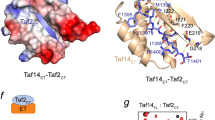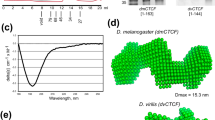Abstract
A KEY component of the RNA polymerase II transcriptional apparatus, TFIID, is a multi-protein complex containing the TATA box-binding protein (TBP) and at least seven tightly associated factors (TAFs)1,2. Although the functions of most TFIID subunits are unknown, it is clear that TAFs are not necessary for basal activity but that one or more are required for regulated transcription, and so behave as coactivators1–4. The presence of multiple subunits indicates that there is an intricate assembly process and that TAFs may be responsible for other activities. We have described the properties of the subunit dTAFII110, which can interact directly with the transcriptional activator Sp1 (ref. 5). In addition, the largest subunit, dTAFII250, binds directly to TBP and links other TAFs to the complex6. Here we describe the cloning, expression and partial characterization of the Drosophila TAF of Mr 80,000, dTAFII80. Sequence analysis reveals that dTAFII80 contains several copies of the WD40 (β-transducin) repeat7. Moreover, dTAFII80 shares extended sequence similarity with an Arabidopsis gene, COP1, which encodes a putative transcription factor that is thought to regulate development8. We have expressed recombinant dTAFII80 and begun to characterize its interaction with other members of the TFIID complex. Purified recombinant dTAFII80 is unable to bind TBP directly or to interact strongly with the C-terminal domain of dTAFII250 (Δ250). Instead, dTAFII80 is only able to recognize and interact with a higher-order complex containing TBP, Δ250, 110 and 60. These findings suggest the formation of TFIID may require an ordered assembly of the TAFs, some of which bind directly to TBP and others that are tethered to the complex as a result of specific TAF/TAF interactions.
This is a preview of subscription content, access via your institution
Access options
Subscribe to this journal
Receive 51 print issues and online access
$199.00 per year
only $3.90 per issue
Buy this article
- Purchase on Springer Link
- Instant access to full article PDF
Prices may be subject to local taxes which are calculated during checkout
Similar content being viewed by others
References
Dynlacht, B. D., Hoey, T. & Tjian, R. Cell 55, 563–576 (1991).
Tanese, N., Pugh, B. F. & Tjian, R. Genes Dev. 5, 2212–2224 (1991).
Pugh, B. F. & Tjian, R. Cell 61, 1187–1197 (1990).
Zhou, Q., Lieberman, P. M., Boyer, T. G. & Berk, A. J. Genes Dev. 6, 1964–1974 (1992).
Hoey, T. et al. Cell 72, 247–270 (1993).
Weinzierl, R. O. J., Dynlacht, B. D. & Tjian, R. Nature 362, 511–517 (1993).
van der Voorn, L. & Ploegh, H. L. FEBS Lett. 307, 131–134 (1992).
Deng, Z.-W. et al. Cell 71, 791–801 (1992).
Fong, H. K. W. et al. Proc. natn. Acad. Sci. U.S.A. 83, 2162–2166 (1986).
Yarfitz, S., Provost, N. M. & Hurley, J. B. Proc. natn. Acad. Sci. U.S.A. 85, 7134–7137 (1988).
Levine, M. A., Smallwood, P. M., Moen, P. T., Hellman, L. J. & Ann, T. G. Proc. natn. Acad. Sci. U.S.A. 87, 2329–2333 (1990).
Peterson, T. A. et al. Nature 309, 556–558 (1984).
Yochem, J. & Byers, B. J. molec. Biol. 195, 233–245 (1987).
Dalrymple, M. A., Petersen-Bjorn, S., Friesen, J. D. & Beggs, J. D. Cell 58, 811–812 (1989).
Banroques, J. & Abelson, J. N. Molec. cell Biol. 9, 3710–3719 (1989).
Williams, F. E. & Trumbly, R. J. Molec. cell. Biol. 10, 6500–6511 (1990).
Williams, F. E., Varanasi, U. & Trumbly, R. J. Molec. cell. Biol. 11, 3307–3316 (1991).
Keleher, C. A., Redd, M. J., Schultz, J., Carlson, M. & Johnson, A. D. Cell 68, 709–719 (1992).
Zinn, K., McAllister, L. & Goodman, C. S. Cell 53, 577–587 (1988).
Poole, S. J., Kauvar, L. M., Drees, B. & Kornberg, T. Cell 40, 37–43 (1985).
Kadonaga, J. T., Carner, K. R., Masiarz, F. R. & Tjian, R. Cell 51, 1079–1090 (1987).
Jantzen, H. M., Chow, A. M., King, D. S. & Tjian, R. Genes Dev. 6, 1950–1963 (1992).
Author information
Authors and Affiliations
Rights and permissions
About this article
Cite this article
Dynlacht, B., Weinzierl, R., Admon, A. et al. The dTAFII80 subunit of Drosophila TFIID contains β-transducin repeats. Nature 363, 176–179 (1993). https://doi.org/10.1038/363176a0
Received:
Accepted:
Issue Date:
DOI: https://doi.org/10.1038/363176a0
This article is cited by
-
Yeast two-hybrid map of Arabidopsis TFIID
Plant Molecular Biology (2007)
-
The role ofSaccharomyces cerevisiae Cdc40p in DNA replication and mitotic spindle formation and/or maintenance
Molecular and General Genetics MGG (1995)
-
Molecular cloning of Drosophila TFIID subunits
Nature (1994)
-
Yeast TAF IIS in a multisubunit complex required for activated transcription
Nature (1994)
-
Miller-Dieker lissencephaly gene encodes a subunit of brain platelet-activating factor
Nature (1994)
Comments
By submitting a comment you agree to abide by our Terms and Community Guidelines. If you find something abusive or that does not comply with our terms or guidelines please flag it as inappropriate.



